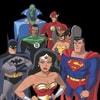

Richard John "Dick" Grayson is a fictional superhero that appears in comic books published by DC Comics. Created by Bob Kane and Bill Finger and illustrator Jerry Robinson, he first appeared in Detective Comics #38 in April 1940. The youngest in a family of acrobats known as the "Flying Graysons", Dick watches a mafia boss kill his parents in order to extort money from the circus that employed them. Batman takes him in as his legal ward and eventually as original incarnation of the crime-fighting partner Robin. He is written by many authors as the first son of Batman. Many, including OMAC, state that he is the one that Batman cares about the most. Throughout his adolescence, Batman and Robin are inseparable. As he grows older and spends more time as the leader of the Teen Titans, however, Grayson retires as Robin and takes on his own superhero identity Nightwing to assert his independence. His Nightwing persona was created by writer Marv Wolfman and artist George Pérez, and first appeared in Tales of the Teen Titans #44. As Nightwing, he leads the Teen Titans and later the Outsiders.

Likes/Dislikes by U.S. Region
73%
27%
72%
28%
73%
27%
75%
25%
76%
24%
Likes/Dislikes by Region
hover over the map to see breakdown
Rankings
SEE ALL RANKINGS
#2
OF 101
People who believe that Dick Grayson is a high quality comic book character also like (or dislike) these…
Help Topic: What do these scores mean?
Comics
Fictional Characters
Films
People
TV
why?


TOON | Animated | 2011 - 2022 | Canceled | 6 Seasons | 57 Episodes
Jesse McCartney, Jason Spisak, Khary Payton
why?


FOX | Animated | 1992 - 1995 | Ended | 4 Seasons | 86 Episodes
Kevin Conroy, Efrem Zimbalist, Bob Hastings
why?


TOON | Animated | 2003 - 2006 | Ended | 5 Seasons | 68 Episodes
Hynden Walch, Scott Menville, Greg Cipes
why?


Cartoon Network | Action & Adventure | 2001 - 2004 | Ended | 2 Seasons | 50 Episodes
Carl Lumbly, George Newbern, Phil LaMarr
why?


YTV | Animated | 2001 - 2004 | Ended | 2 Seasons | 66 Episodes
Antoine M. Dillard, Natasha L. Dillard
why?


WB | Animated | 1999 - 2001 | Ended | 3 Seasons | 52 Episodes
Will Friedle, Kevin Conroy, Cree Summer
why?


WB | Animated | 1997 - 1999 | Ended | 5 Seasons | 24 Episodes
Kevin Conroy, Mathew Valencia, Tara Strong
why?


NIKTON | Animated | 2005 - 2008 | Ended | 3 Seasons | 71 Episodes
Zachery Tyler, Mae Whitman, Jack De Sena
why?


FOX | Animated | 1992 - 1997 | Ended | 5 Seasons | 76 Episodes
Cal Dodd, Cedric Smith, Norm Spencer
why?


WBL | Animated | 1996 - 2000 | Ended | 3 Seasons | 54 Episodes
Tim Daly, Dana Delany, Clancy Brown
Games
Sports
Music
Books
Audience Affinity
Sci-fi & Fantasy
62
Comics & Graphic Novels
56
Entertainment
39
Anime Movies
32
Anime
32
Crime
-6
Console Games
-8
Sitcoms
-8
Fast Food
-9
Food & Drink
-9












































































































